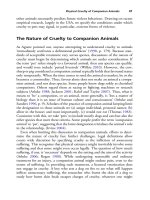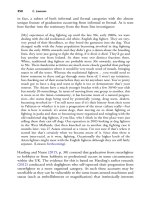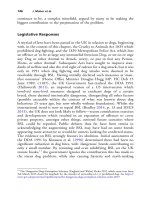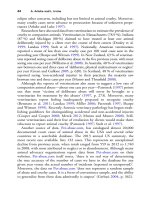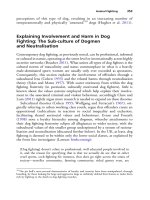The palgrave international handbook of a 155
Bạn đang xem bản rút gọn của tài liệu. Xem và tải ngay bản đầy đủ của tài liệu tại đây (28.09 KB, 1 trang )
146
J. Maher et al.
continues to be, a complex minefield, argued by many to be making the
biggest contribution to the perpetuation of the problem.
Legislative Responses
A myriad of laws have been passed in the UK in relation to dogs, beginning
with, in the context of this chapter, the Cruelty to Animals Act 1835 which
prohibited dog fighting, and the 1839 Metropolitan Police Act, which lists
an offence as ‘to be at large any unmuzzled ferocious Dog, or set on or urge
any Dog or other Animal to Attack, worry, or put in fear any Person,
Horse, or other Animal’. Subsequent Acts have sought to improve standards of welfare and also the civil right of redress for a dog attack, but it was
only in 1991 when dog fighting and dog attacks were deemed to be
resolvable through BSL. Having initially declared such measures as ‘manifest nonsense’ (Home Office Minister Douglas Hogg MP, HC Deb 15
June 1989, c1187), the UK Government fast-tracked the DDA 1991
(Hallsworth 2011), an imported version of a US intervention which
involved state-level measures designed to eradicate dogs of a certain
breed, those deemed intrinsically dangerous, disregarding all other factors
(possibly excusable within the context of what was known about dog
behaviour 25 years ago, but now wholly without foundation). Whilst the
international trend is now to repeal BSL (Bradley 2014, p. 13 and HSUS
2015), the UK does not look likely to follow—recent consultation exercises
and developments which resulted in an expansion of offences to cover
private property, amongst other things, omitted future scenarios where
BSL could be repealed. Public debates thus far have been remiss in
acknowledging the augmenting role BSL may have had on some breeds
appearing more attractive to would-be owners looking for conferred status.
The evidence on BSL strongly favours its abolition. Initial assessments of
the DDA 1991 by Klaassen et al. (1996) determined there had been no
significant reduction in dog bites, with ‘dangerous’ breeds contributing to
only a small number. By retaining and even solidifying BSL on the UK
statute books,11 the government ignores the contribution this has made to
the status dog problem, while also causing hysteria and myth-making
11
The Dangerous Dogs Exemption Schemes [England and Wales] Order 2015 which came into force
3rd March 2015 closes the loophole for the transfer of ownership of a s1 prohibited dog. See https://
www.gov.uk/government/publications/the-dangerous-dogs-exemption-schemes-order-2015


